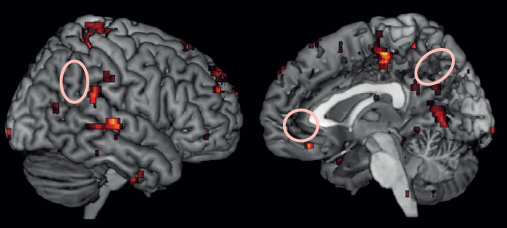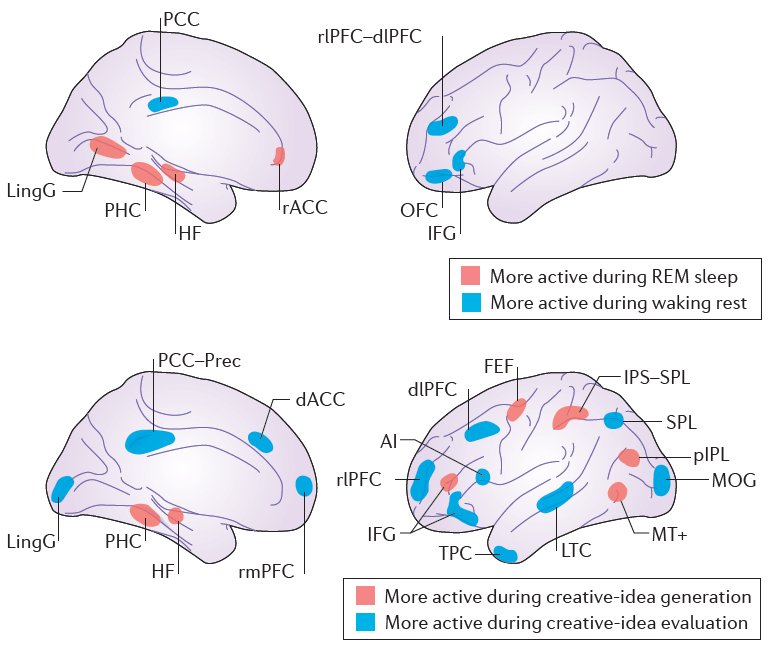Neuroscience review reframes ‘mind-wandering’ and mental illness
November 4, 2016

Brain regions within the core default network subsystem (DNCORE) that are more active during task-unrelated thought than during task-related thought (credit: Kalina Christoff et al./Nature Reviews Neuroscience)
In a review of neuroscience literature from more than 200 journals, published in Nature Reviews Neuroscience, a University of British Columbia-led team has proposed a radical new framework for understanding “mind wandering” and mental illness.
Within this framework, spontaneous thought processes — including mind-wandering, creative thinking, and dreaming — arise when thoughts are relatively free from deliberate and automatic constraints. Mind-wandering is not far from creative thinking.
“We propose that mind-wandering isn’t an odd quirk of the mind,” said Kalina Christoff, Ph.D., the review’s lead author and a professor of psychology at UBC. “Rather, it’s something that the mind does when it enters into a spontaneous mode. Without this spontaneous mode, we couldn’t do things like dream or think creatively.”
How mental disorders disrupt mind-wandering and creativity
“Mind-wandering is typically characterized as thoughts that stray from what you’re doing, but we believe this definition is limited,” Christoff said. Instead, mind-wandering happens when thoughts flow freely (that is, when the mind is in its default state).
In contrast, mental disorders, such as anxiety and depression, arise when two types of constraints — automatic and deliberate — disrupt free movement of thoughts and ideas.

(Top) Brain regions more active during REM sleep vs. during waking rest. (Bottom) Brain regions more active during creative-idea generation vs. during creative-idea valuation (credit: Kalina Christoff et al./Nature Reviews Neuroscience)
“Sometimes the mind moves freely from one idea to another, but at other times it keeps coming back to the same idea, drawn by some worry or emotion,” said Christoff. “Understanding what makes thought free and what makes it constrained is crucial because it can help us understand how thoughts move in the minds of those diagnosed with mental illness.”
The team’s meta-analysis reframes disorders, anxiety, and ADHD, for instance, as extensions of a normal variation in thinking, the researchers explain. The anxious mind helps us focus on what’s personally important, while the ADHD mind is marked by an excessive variability in thought (too much spontaneity).
This new perspective on mind-wandering could help psychologists gain a more in-depth understanding of mental illnesses, said review co-author Zachary Irving, a postdoctoral scholar at the University of California, Berkeley, who has ADHD.
The review was also co-authored by a researcher from Cornell University and one from the University of Colorado Boulder.
Abstract of Mind-wandering as spontaneous thought: a dynamic framework
Most research on mind-wandering has characterized it as a mental state with contents that are task unrelated or stimulus independent. However, the dynamics of mind-wandering — how mental states change over time — have remained largely neglected. Here, we introduce a dynamic framework for understanding mind-wandering and its relationship to the recruitment of large-scale brain networks. We propose that mind-wandering is best understood as a member of a family of spontaneous-thought phenomena that also includes creative thought and dreaming. This dynamic framework can shed new light on mental disorders that are marked by alterations in spontaneous thought, including depression, anxiety and attention deficit hyperactivity disorder.